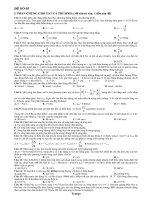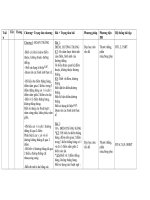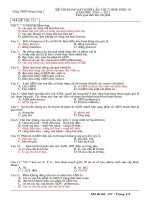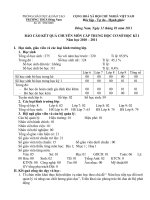Bài giảng [DOC] BTCN mẫu môn học QTSX
Bạn đang xem bản rút gọn của tài liệu. Xem và tải ngay bản đầy đủ của tài liệu tại đây (1009.31 KB, 15 trang )
Supject: MGMT540 Operations Management
Class: GaMBA01.C02
Student: Trương Minh Chiến, ID# 113408
Final Individual Assessment
TOPIC: IMPROVED LEAN SYSTEM OF
TOYOTA CORPORATION BY APPLIED
MODERN PROBABILITY STATISTIC
THEOREM AND 6 SIGMA MODEL
INTRODUCTION
1 - Background
Toyota Group is one of the groups leading car manufacturer in the world. But in recent years, U.S.
Toyota in US had a recall of over 8.5 million cars and make the company $30 billion hole in the
system caused by the brake pedal and no security technique makes all the operators can not operate
the vehicle the speed they desire. This shows the weakness in the production stage manager as well as
errors in the information management system of the Toyota corporation.
Figure 1 Analysis of errors on the accelerator and brakes of the Toyota’s cars
On the other hand, the production management system of the Toyota (TPS - Toyota Production
System) is a system that Lean forward in the decades 80s, 90s. I will analyze the drawbacks of the
TPS. Moreover, I will use the theory of production management and probability statistics to make
some suggestions to overcome the disadvantages of the production management system TPS.
1/ 15
INTERNATIONAL MASTER OF BUSINESS PROGRAM
Website: www.griggs.edu.vn Email:
1
2 - Purposes
The purpose of this project is to analyze, evaluate and respond to questions in the case study in which
are crisis in production management and quality management of Toyota. Based on these results, I will
make proposals on the application model combines Lean and 6 Sigma, for example, combining the
quality control system of models such as Six Sigma FMEA, QFD, EFM and SIPOC model TPS -
Toyota's traditional Lean system,
3 - Progress
This report is realized bases upon below steps:
i. Understand and gather information Toyota case study – crisis in productions management and
quality management.
ii. Analysis and evaluation the realistic situation.
• Analysis the problem.
• Applied operations management [Appendix 1,2].
• Applied probability and statistic theorem for problem solving.
iii. Conclusion and recommendation.
ARTICLES and ANSWERS
Case study Toyota – production system :
Read the following articles [Reference 8] about the situation of Toyota company and answer the
questions below:
Question 1: Let you indicate the mode of governance that the company Toyota production applied?
Question 2: Which defects in the operation of international business administration of Toyota
Corporation that has led to this tragedy?
Question 3: Could you set out how the handle this problem from your viewpoint?
(TBKTSG) - The Toyota group's problems clearly illustrates weaknesses of the operating
mechanism of Japanese enterprises.
It is difficult to exaggerate the importance of Toyota in the psychology of Japanese business. Toyota
has long been considered the pinnacle of creativity, production quality and the power industry in
Japan - especially after the company past General Motors (USA) became the largest car manufacturer
around the world in 2008.
2/ 15
INTERNATIONAL MASTER OF BUSINESS PROGRAM
Website: www.griggs.edu.vn Email:
2
The technical management and production of the Toyota organization, referred to as TPS (Toyota
Production Systems), such as streamlining the process of "Lean" supply system "in time" (Just-in-
Time), the guideline "continuous improvement (Kaizen) ... Toyota has become the envy of all trust
business. Many companies around the world send expert team to visit the Toyota factory in hopes of
learning is part of the public record of managing it. In Japan, Toyota is considered a champion of
industry, along with Sony and Hitachi.
But only a few weeks ago, things have changed. The recovery (recall), nearly 8.5 million cars Toyota
worldwide due to technical deficiencies endanger the safety for the users has caused a worsening
crisis.
Since November last year, Toyota started withdrawal of 3.8 million cars to repair parts of the
accelerator, to overcome unwanted vehicle acceleration. 1-2010 to May, Toyota recall to 2.3 million
vehicles on the same reason, and stop production at five factories in the U.S.. 9-2 days, Toyota recalls
440,000 additional hybrid vehicles (both cars have gasoline-electric), including the popular Prius
model, to fix a problem in parts wins. According to Reuters news agency on 23-2, Toyota is also
considering withdrawal Corolla - selling car after the Camry Monday - due to problems in parts of the
wheel.
A survey of the U.S. Department of Traffic Safety (NHTSA) is conducting shows defects not only in
separate parts but also in system software controls the line of Toyota vehicles. Wednesday 24-2
yesterday, Toyota president and other senior officials of Toyota in the U.S. have a hearing before
Congress this country.
So funeral stage reputation for quality on which Toyota built their work. The company's stock price
has fallen about 30 billion dollars, equivalent to the entire market value of Ford Motor.
But it is worth noting that according to analysts, this disaster is not only due to technical errors in the
components of a car which is mainly caused by management company has not recognized correctly
and properly handle the situation crisis.
Toyota's problems are detected early. According to the Center for Strategic Research Safety (SRS) is
headquartered in Boston, from 1999 to now the center has recorded for 2262 Toyota unintended
acceleration caused at least 819 crashes to 26 people death. Thousands of complaints, an application
related to the fatal accident, has been submitted to the National Highway Traffic Safety (NHTSA) and
Toyota, but companies are not being met.
Initially, Toyota has vehemently denied the defect in the product. Until last month they recognized
11-2009 pedal parts may cause problems for car speeding out of control, but said that due to vacuum
the carpet lined improperly installed. By the end of the month 1-2010, as more evidence that the
3/ 15
INTERNATIONAL MASTER OF BUSINESS PROGRAM
Website: www.griggs.edu.vn Email:
3
defect lies not in the carpet lining in the legs that increase speed down mechanism, Toyota was forced
to withdraw again to 2.3 million vehicles.
This time Toyota "dump" the responsibility for CTS Corp. company. - A manufacturer of car parts in
Indiana, USA - is a supplier of accelerator components for Toyota, however CTS Corp. quickly
objected, said the new CTS offers only the accelerator - is made in accordance design and quality
requirements of the Toyota - from late 2005, while the model error has appeared since 1999.
This interpretation of the Toyota quickly becoming skeptical, especially as more defects are found not
only in parts of the accelerator and brake. How to handle just slowly just to avoid the responsibility of
the Toyota has devastated confidence that customers place on this brand.
When the press both in and outside Japan to the front page is not good information about Toyota
products, the leadership of the group almost disappeared. It was not until days 5-2, Mr. Akio Toyoda,
53, president of Toyota and is the grandson of the founder of the group, appeared in public and
apologized, but seems reluctant to clear.
Only the day 8-2, when the Manhattan District Prosecutor's Office, the state of New York requires a
warrant criminal prosecution, the Toyota board the views and attitudes have changed. (Manhattan
Prosecutor's Office has jurisdiction over all public companies listed and traded shares in the stock
market on Wall Street New York Street in Manhattan that Toyota is one of such companies).
In a presentation posted on the Wall Street Journal earlier this week issued before the hearing before
the Review Commission and the Government Reform U.S. House of Representatives, Mr. Akio
Toyoda was first admitted: "I clearly see that in recent years, we did not listen carefully and do not
respond as fast as we would have to do before the customer's concerns. Despite the attention to
investigate the defect, we only focus on technical issues without full attention to the way used car
consumer. " Akio Toyoda, and he received all the responsibility as the head whether he was sworn in
June from last year.
Crisis resolution is disappointing things that happened at Toyota, but as The Economist, they reflect a
collective failure of the operating businesses in Japan, making the company vulnerable to large errors
in handle negative situations. Almost any Japanese company also maintains a system of strict
hierarchies, in which the elderly are revered, subordinates hardly dared to report to their superiors
information that is not nice, that information is not to be competent authorities or to please the wife
round leaders.
Family relationships, relatives interlaced makes this system more sustainable; those who "exceeded
supply report" were considered unreliable and violating cultural norms of the business. Groupthink, a
4/ 15
INTERNATIONAL MASTER OF BUSINESS PROGRAM
Website: www.griggs.edu.vn Email:
4
collective responsibility to become the guideline for management executives do not tend to move
between firms: the hiring of external experts is considered to break the internal harmony of the
company, professionals want to work is considered "the dance of" lack of loyalty.
Sticky like family culture that not only hinder the ability to act boldly and resolutely by Japanese
companies but also made the company fall asleep on his achievement that few consumers care about
and lack of permanently monitoring mechanism and criticism. Particularly at Toyota, including 29
board members are Japanese and have a "home" (insider), does not have an independent expert. Other
Japanese companies also lack such diversity, with the exception of Sony and eAccess.
Many Japanese companies are now reviewing the experiences of Toyota, such as the use of outside
resources to lower production costs, depending on the supplier and relationship management with
agencies quality ... However, it is important to Toyota's problems, perhaps they should reconsider the
way in the internal governance as well as in business relationships with customers, users and products
their services.
(Theo Economist, Time and Reuters) - [Reference 8]
5/ 15
INTERNATIONAL MASTER OF BUSINESS PROGRAM
Website: www.griggs.edu.vn Email:
5
Problem solving
Answer to question 1
Production management model of Toyota (TPS) is a model that combines the application of Lean JIT
inventory management system of materials and methods of chain U - Kanban (pull method of line
with U the production stages are arranged in a U-shaped) and quality management processes Jidoka
(check truou Visualization and corrects problems or incidents).
Figure 2 The productions management model of TPS of Toyota.
Specifically, Toyota officials and employees to continually hunt for paying all the wasted resources.
Toyota's leadership theory is as follows. Value added is the effect of price and cost. Added value will
increase if firms raise prices or reduce costs. If the price increase, the firms will lose customers and
degradation. If the cost reduction will not be subject to the disadvantages that could reduce the market
price and robbed of competition.
Toyota classified three main sources of waste: muda (無益), muri (無理) and mura (斑). Restrictions
to waste and expense, the industrial management engineer Taiichi Ohno Japanese, Shigeo Shingo, and
Masaaki Imai Genichi Taguchi has created a number of management philosophies such as just in time
(just in time production), SMED (Single minute exchange of die, tool change in a minute), kaizen (改
善), genchi genbutsu (現地現物), heijunka (平準化),... and some tools as executive producer jidoka
(自働化) , nemawashi (根回), andon (行灯), kanban (看板), poka yoke (差错预防),...
6/ 15
INTERNATIONAL MASTER OF BUSINESS PROGRAM
Website: www.griggs.edu.vn Email:
6









